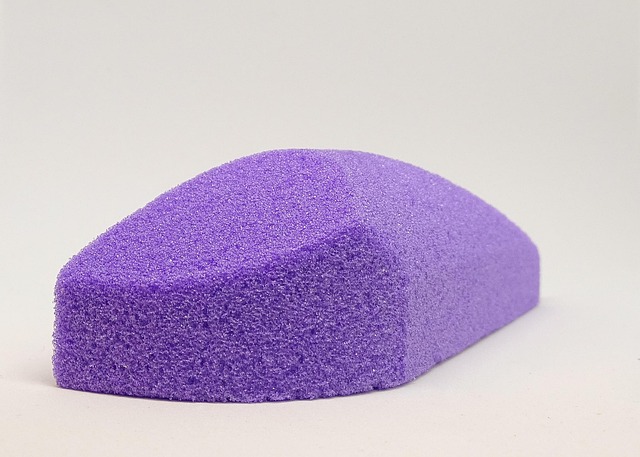Understanding grout stain causes is key for effective treatment. Regular cleaning with mild detergent and water handles minor stains, while specialized cleaners or natural remedies tackle tougher cases. Test solutions discreetly first. Essential tools include a grout cleaner, soft-bristled brush, bucket, vacuum, gloves, goggles, mild detergent, and warm water. Maintain grout lines by sweeping/vacuuming regularly, using mild detergent, and avoiding harsh chemicals. Act promptly on stains, deep clean every 3-6 months, and call professionals for stubborn cases or extensive damage.
Professional grout stain treatment is essential for maintaining the cleanliness and aesthetics of your tiled surfaces. This comprehensive guide delves into the science behind grout stains, providing a step-by-step approach to their effective removal. From identifying causes to choosing the right materials, we cover it all. Learn how to avoid common mistakes and implement maintenance tips for prolonged results. Discover when professional help is the best course of action for stubborn grout line stains.
Understanding Grout Stain Causes

Grout stain causes can vary, but understanding them is key to effective treatment. Many stains result from everyday wear and tear, including dirt, grime, and spills that settle into the tiny crevices of grout lines. Other factors like moisture, lack of ventilation, or using incompatible materials during tile installation can also contribute to staining. Identifying the specific cause is crucial when tackling stain removal from grout lines.
Once you know what’s causing the stain, removing it becomes more manageable. Regular cleaning with a mild detergent and warm water can help with minor stains. For tougher cases, specialized grout stain cleaners or natural remedies like baking soda and vinegar might be needed. Always test any cleaning solution in an inconspicuous area first to ensure it won’t damage or discolor your grout.
Materials Needed for Stain Removal

To effectively remove stains from grout lines, you’ll need a few key materials. Start with a good quality grout cleaner or stain remover, which can be found at most hardware stores. These products are designed to penetrate and lift stubborn stains without damaging the grout. Next, gather some essential tools like a soft-bristled brush or sponge for applying the cleaner, a bucket for mixing solutions, and a vacuum or wet/dry vacuum for thorough cleaning.
Don’t forget protective gear such as gloves and goggles to shield yourself from harsh chemicals. Additionally, prepare a solution of warm water and mild detergent for rinsing after treatment. Proper preparation ensures that your grout lines not only look clean but also stay that way longer.
Step-by-Step Guide to Cleaning

Removing stains from grout lines is a crucial step in maintaining your professional grout stain treatment. Begin by sweeping or vacuuming the floor to eliminate loose debris. Next, mix a solution of warm water and mild detergent; ensure the mixture is not too strong to avoid damaging the grout. Dip a soft-bristled brush into the solution and gently scrub the stained areas, applying firm yet gentle pressure. For tougher stains, consider using a grout cleaning tool or an old toothbrush for more targeted cleaning.
Rinse the floor thoroughly with clean water after scrubbing to eliminate any residue. Dry the surface with a microfiber cloth or sponge to prevent streaking and ensure optimal results. Regularly cleaning and maintaining your grout lines will help preserve their appearance and extend the life of your professional grout stain treatment.
Common Mistakes to Avoid

When it comes to grout stain treatment, there are several common mistakes that homeowners often make. One of the biggest is delaying the cleaning process. Stains can set in quickly, especially with moisture from showering or cooking. Waiting too long makes removal more difficult. Another mistake is using harsh chemicals without proper protective gear, which can be damaging to both your health and the grout itself.
Additionally, not identifying the root cause of the stain can lead to recurring issues. For example, a leak under the tile might contribute to discolouration, so fixing the source is key. Lastly, skimping on quality cleaning products designed for grout won’t deliver effective results. Always opt for products specifically formulated to remove stains from grout lines for the best chance of successful treatment.
Maintenance Tips for Longevity

Regular maintenance is key to keeping grout lines looking pristine and stain-free for longer. After initial cleaning, establishing a consistent cleaning routine is essential. This involves regularly vacuuming or sweeping to remove surface dirt and debris, focusing on areas with high foot traffic or prone to staining.
When it comes to removing stains from grout lines, prompt action is vital. As soon as a stain appears, use a grout cleaner or mild detergent to gently scrub the affected area. Regularly deep cleaning every 3-6 months will help prevent stubborn stains from setting in, ensuring your grout lines remain vibrant and fresh.
When to Consider Professional Help

If you’ve exhausted all home cleaning methods and still can’t remove stubborn grout stains, it might be time to consider professional help. Grout stain treatment is a specialized service that goes beyond standard cleaning routines. Professionals are equipped with advanced tools and knowledge to tackle deep-set dirt, mold, or mildew issues that have become embedded in the grout lines over time.
Engaging a professional service for grout stain removal can be particularly beneficial when dealing with extensive grout damage, such as severe discoloration, texture changes, or structural deteriorations caused by water penetration. Homeowners should seek expert assistance if their efforts to clean the stains have resulted in further discoloration or if they want to prevent future issues by addressing underlying problems effectively.
